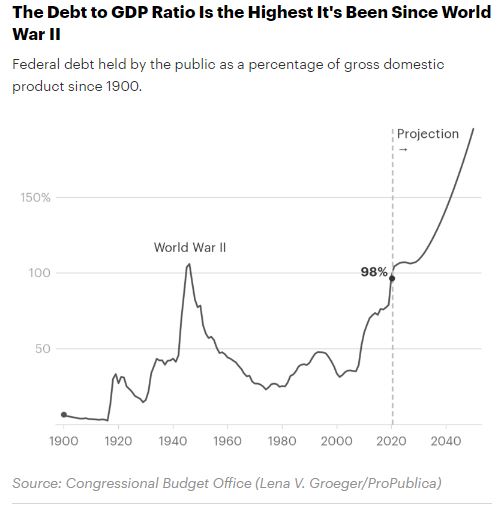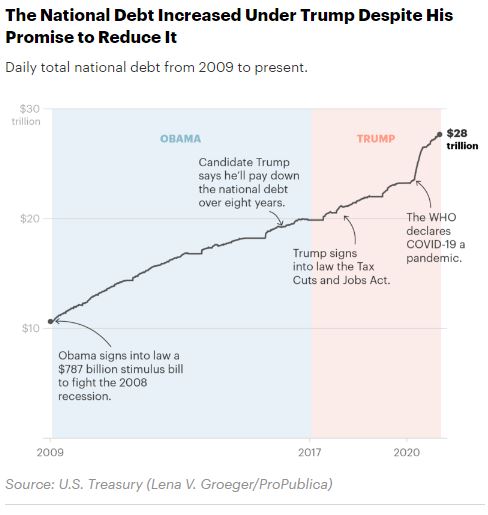As the 2024 presidential race intensifies, economic policies have taken center stage. A recent analysis from the Penn Wharton Budget Model (PWBM), a nonpartisan group within the University of Pennsylvania—Donald Trump’s alma mater—delivers a sobering assessment of his economic proposals. According to the report, Trump’s plan would increase the federal deficit by a staggering $5.8 trillion over the next decade and reduce long-term economic growth, posing severe risks to the future of the U.S. economy.
The Impact of Trump’s Economic Plan
The PWBM report estimates that Trump’s proposed policies, which include significant tax cuts and increased defense spending, would lead to an unsustainable fiscal path. The analysis projects that these policies would initially boost economic activity, but the benefits would be short-lived. Over the next 30 years, the U.S. Gross Domestic Product (GDP) is expected to decrease by 2.1%, reflecting the long-term damage of ballooning deficits and rising debt.
This projected decline in economic growth is particularly alarming when compared to the expected outcomes of Kamala Harris’s economic plan. Harris’s policies, which focus on investments in education, healthcare, and infrastructure, are expected to increase the federal deficit by $2.7 trillion over the next decade—less than half of Trump’s projected deficit. Importantly, her plan is anticipated to increase GDP by 1.5% in the long term, a stark contrast to the economic contraction forecasted under Trump’s policies.
Wharton shows a high level impact of Trump’s plan:
- We project that spending increases by $2.3 trillion over 10 years while conventional tax revenue increases by $1.1 trillion, for a difference in primary deficits of $1.2 trillion. Accounting for negative economic feedback effects, primary deficits increase to $2 trillion.
- Relative to current law, GDP falls by 1.3 percent by 2034 and by 4 percent within 30 years (year 2054). Capital investment and working hours fall, thereby reducing wages by 0.8 percent in 2034 and by 3.3 percent in 2054.
- Low- and middle-income households in 2026 and 2034 fare better under the campaign proposals on a conventional basis, while households in the top 5 percent of the income distribution fare worse. These conventional gains and losses do not include the negative impact of the additional debt burden on future generations who must finance most of the spending increases.
Comparing Harris’s and Trump’s Economic Plans
Stay up-to-date with the latest news!
Subscribe and start recieving our daily emails.
While both candidates’ plans would increase the federal deficit, the long-term outcomes could not be more different. Harris’s focus on infrastructure and human capital is expected to yield economic growth and improve the nation’s fiscal health over time. In contrast, Trump’s tax cuts, heavily weighted towards corporations and high-income earners, would initially stimulate the economy but ultimately lead to a reduction in economic growth and a much larger federal deficit.
The disparity between the two candidates’ plans is further highlighted by this analysis. One report states that Trump’s base remains strong, but his economic proposals expose significant vulnerabilities. As we wrote before, “the erosion of support among crucial voter groups reveals vulnerabilities that could impact his campaign”. This erosion is likely tied to concerns over the long-term economic damage his policies may inflict.
CNBC’ wrote about this as well; their headline was: ‘Trump budget would spike deficits by nearly 5 times Harris proposal, says Penn Wharton’. They also mentioned Trump’s impact on inflation:
And more broadly, economists warn that such a hard-line tariff policy would likely reignite inflation, just as the rate of consumer price increases has begun to cool.
The Long-Term Consequences of Ballooning Deficits
The implications of a $5.8 trillion increase in the federal deficit under Trump’s economic plan are extensive and concerning. As the national debt escalates, the U.S. government will face higher interest payments, potentially crowding out crucial investments in infrastructure, education, and social programs. Increased government borrowing could also lead to higher interest rates, making it more expensive for businesses and consumers to borrow, thereby stifling economic growth.
Kamala Harris’s economic plan, while also increasing the deficit by $2.7 trillion over a decade, offers a more balanced approach by focusing on long-term investments that could foster economic growth. Biden’s economic policies have also contributed to the deficit, with the national debt increasing by approximately $3.7 trillion during his first two years in office. However, Biden’s spending has been largely focused on infrastructure, pandemic relief, and long-term investments aimed at stabilizing the economy during unprecedented times. In contrast, Trump’s approach focused heavily on tax cuts, particularly benefiting corporations and high-income earners, leading to a significant increase in the deficit without a proportional boost in long-term economic growth.

Under Trump, the federal deficit increased by about $7.8 trillion during his four years in office, driven by tax cuts, increased military spending, and pandemic relief efforts. In comparison, Biden’s policies, while also contributing to the deficit, are aimed at fostering long-term economic stability and growth through targeted investments.
In scenarios where debt levels continue to rise unchecked, the U.S. risks facing a fiscal crisis, where investors may demand higher interest rates to compensate for lending to a heavily indebted government. This could lead to a vicious cycle of increasing debt and interest payments, further straining the federal budget.

Despite these challenges, the U.S. remains the most dynamic and best-positioned large economy globally, with its diverse and innovative economy, strong institutions, and deep financial markets providing a solid foundation for future growth. However, careful fiscal management is crucial to ensuring that the economy can continue to thrive without being weighed down by unsustainable debt levels.
We Got It Bro; You Went To Wharton
This is what PhillyMag had to say about Trump‘s relationship to Wharton in 2019:
Ahh, the college transcript. Trump famously graduated from Penn’s Wharton School in 1968 — a fact he reminds audiences of over and over again. (Per Penn’s student newspaper, the Daily Pennsylvanian, he publicly name-dropped Wharton 52 times between June 2015 and January 2018.) But despite all his humblebragging about that Wharton degree, Trump has never allowed his academic performance there to be made public.
“This was a major, major thing with Trump — that people might think he’s stupid,” Michael Wolff told me around the time of Siege’s publication earlier this summer. “The focus of that for Trump is the college transcripts, which are apparently terrible. I’ve spoken to friends of Trump from that time, and this was a guy that was obviously not interested in school and possibly never read a book in his life. For everyone that had known him then and years afterward, the assumption was that he had terrible grades, he was a lackluster student at best.”
In 2018, the Daily Pennsylvanian wrote about how many times that Trump reference Wharton … so we know he respects their amazing, amazing work:
As we fast approach the one-year mark, The Daily Pennsylvanian decided to count just how many times Trump has called on Penn in relation to himself. The results speak for themselves: Since May 16, 2015, Trump is documented to have referenced his education 93 separate times.
From June 16, 2015 to Jan. 11, 2018 where he mentioned Wharton in his interview with the Wall Street Journal, Trump has said “Wharton” 52 times. Over the same time period, he has noted that he went to an Ivy League school 12 times, and referred to himself as a “good student” (or some variant like “great” or “excellent”) 27 times.
Where Things Are Heading
The analysis from the Penn Wharton Budget Model should serve as a wake-up call. While Trump’s economic plan may offer short-term benefits, the long-term consequences could be devastating. In contrast, Kamala Harris’s proposals, though also increasing the deficit, offer a more balanced approach that promotes long-term growth. As voters consider their options in the upcoming election, the stark differences between these two economic visions should be at the forefront of the discussion.
With the stakes so high, it is crucial that the next administration adopts policies that not only address immediate economic concerns but also ensure the long-term prosperity of the nation. The future of the U.S. economy depends on it.
Featured image via creative commons
